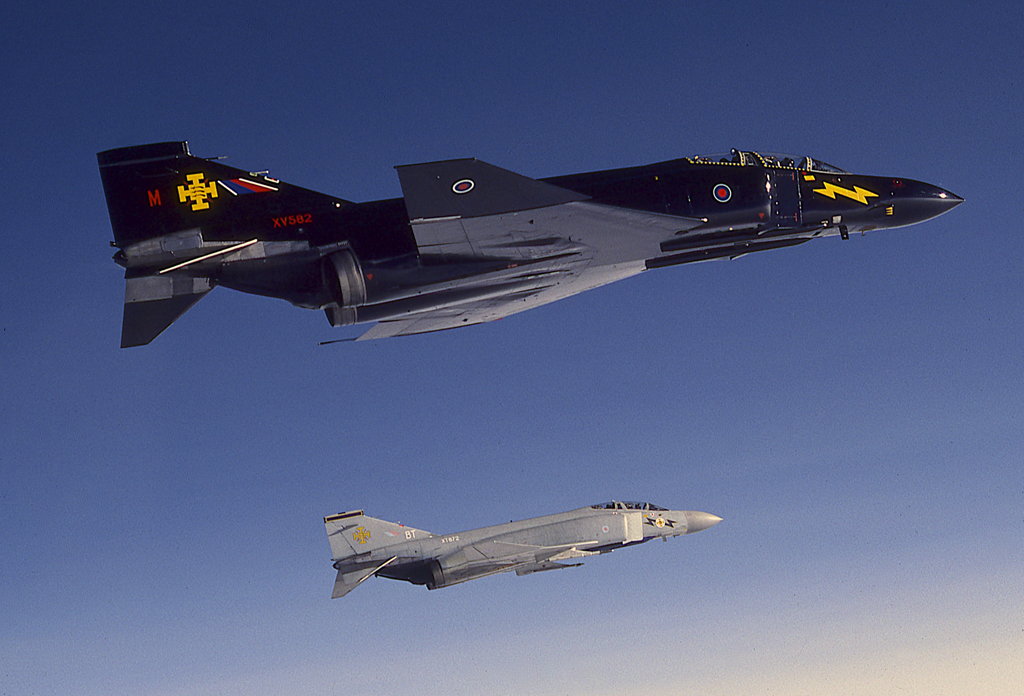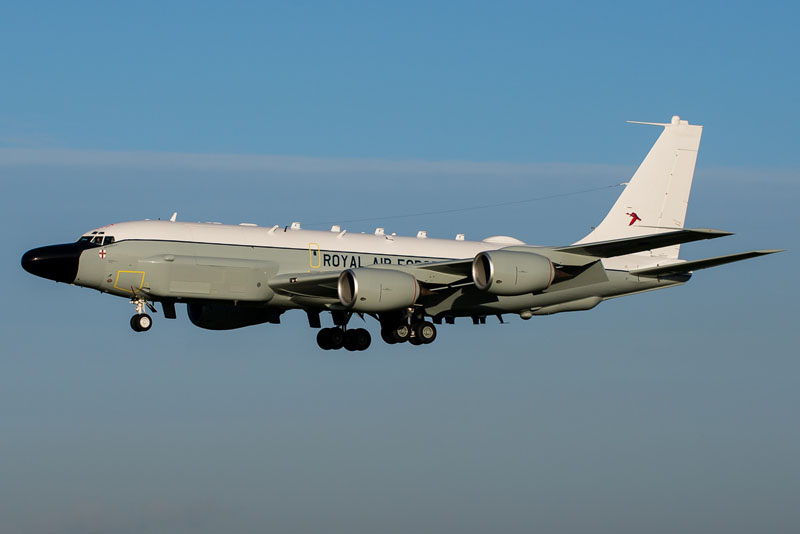Dave Gledhill, GAR’s resident former Phantom Navigator, explains why saving XV582, ‘Black Mike’, is so important – and what you can do to help.
The McDonnell Douglas F4 Phantom II was the cornerstone of the UK air defence force during the Cold War, serving alongside the Lightning as Britain’s principal fighter. When the Phantom was ordered following the cancellation of the TSR2 project and the later cancellation of the order for the F-111 bomber it was decided to incorporate British technology into the design. In addition to British avionics, the fuselage was entirely redesigned to accommodate a military version of the Rolls Royce Spey 202 reheated turbofan engine. There were two marks of the Spey-powered Phantom, the FG Mark 1 and the FGR Mark 2 denoting the roles of fighter, ground attack and reconnaissance.
At the height of the Cold War there were six operational squadrons of Phantoms plus the Operational Conversion Unit. A total of 170 airframes were delivered comprising 52 F4K FG1s and 118 F4M FGR2s of which two were YF4Ms which were used for testing. Initially operated by the Royal Navy from HMS Ark Royal and ashore at Yeovilton, when the RN retired the Phantom from service those airframes were transferred to the RAF and RAF Leuchars in Scotland became the only FG1 base. With other bases at RAF Coningsby in Lincolnshire, RAF Wattisham in Suffolk, RAF Wildenrath in Germany and RAF Stanley in the Falkland Islands the type was a common sight around the world.
Even though it had a good reputation for safety during its service life in both services, many Phantoms were lost. Between July 1969 and January 1991, 32 FGR2s and 7 FG1s crashed and 32 pilots and navigators lost their lives.

Black Mike in her heyday © Ian Black www.firestreakbooks.com
The FG1 retained some of the aerodynamic modifications which allowed it to operate from the carriers such as “fast” reheat, an extendable nosewheel, cockpit operated wing fold and a slotted “stabilator”, although these modifications were slowly removed in RAF service. With the addition of an inertial navigation system, a high frequency radio and an internal battery, the FGR2 was even more adaptable. Both marks were fitted with the highly capable pulse Doppler AN/AWG11/12 radar, Sparrow, (and later Skyflash), and Sidewinder air-to-air missiles and the Suu-23 gunpod carried on the centreline station. In its reconnaissance role the FGR2 could carry the Thorn EMI reconnaissance pod again fitted to the centreline station. With its external fuel tanks the Phantom could remain on combat air patrol for up to two hours.
The Phantom was retired from RAF service in 1992 with the last squadrons flying from RAF Wattisham. Following its retirement the majority of airframes were marked with large blue crosses and rendered unflyable. The sight of the derelict airframes arranged around the “Wattisham Graveyard” in full view of the Russian satellites was heartbreaking for former air and ground crews. With its retirement verified under the terms of the Conventional Forces in Europe Agreement, the role of air defence of the UK passed to the Tornado F3.
MoD policy for retired airframes is that, other than gate guardians, one example of each type is retained at each of the official aviation museums at Hendon and Cosford. Ironically, some preservation attempts have been thwarted for this reason because, as an American supplied airframe, “end user agreements” have meant that airframes were destroyed rather than preserved to avoid the ageing technology falling into unfriendly hands. Hopefully, by now, this risk is past.
A few examples of the Phantom were saved including XV424 which once sported a commemorative colour scheme of its own when it crossed the Atlantic Ocean in 1979 to commemorate the 60th Anniversary of the transatlantic flight of Alcock and Brown. Another complete airframe, XV474, also survives in the Imperial War Museum at Duxford and the first aircraft delivered to the RAF, XT891 still serves as a gate guardian at RAF Coningsby. The Fleet Air Arm Museum at RNAS Yeovilton, Somerset, is home to an FG1, XT596, but most other complete airframes are now in private hands and some that live outside and are unprotected are slowly deteriorating. A few cockpits also survived but most examples of this once proud aircraft were reduced to scrap. Those serving in the Falklands were broken-up and dumped in a water-filled pit on Mount Pleasant airfield. The one survivor, XV409 was finally broken up in 2012 and only the cockpit survives in a museum in Stanley. For that reason time is now of the essence.

An archive image of Black Mike © Gareth Stringer www.globalaviationresource.com
In UK, one notable airframe survived the destruction and it is, perhaps, one of the best maintained and protected examples which remain of this iconic airframe. “Black Mike”, XV582, was painted in a commemorative gloss black paint scheme by 111 (F) Squadron in the late 1980s and carries their distinctive Squadron colours. It has a unique history of its own. The paint scheme was a tribute to the historic formations flown by the Squadron during the Hunter ‘Black Arrows’ and Lightning eras. The aircraft has a significant heritage that gives it a rare provenance. It was the only Phantom FG1 ever to serve on No. 228 Operational Conversion Unit, the first to pass 5000 flying hours and it was also the aircraft which completed the record-breaking “Lands End to John O’Groats run” on 1 Apr 1988, in just 46 minutes 44 seconds. The flight averaged over 757mph for the 590 mile distance and was flown by No. 43 (Fighter) Squadron’s Commanding Officer Wing Commander John Brady with his navigator Squadron Leader Mike Pugh.
The preparation and application of the commemorative colour scheme took many hours of dedicated effort and the aircraft made its debut at the Station Open Day on 23 September 1989. With only limited fatigue life remaining the airframe was intended to be shown only on static display but such was the interest that the scheme was retained for posterity. It received important patronage when the Commander in Chief RAF Strike Command, Air Marshal Sir Patrick “Paddy” Hine, himself an ex-Black Arrow and Phantom pilot, decided that he would fly “Black Mike” himself.
When it retired at RAF Leuchars it was displayed, initially, outside the 111(F) Squadron Headquarters as an unofficial gate guard. With the retirement of the Tornado F3 and the disbandment of 111(F) Squadron, the airframe was moved into a hardened aircraft shelter and used as a ground instructional airframe, occasionally appearing at the annual airshow. For that reason it has survived in remarkably good condition. With the impending closure of Leuchars as an RAF station the airframe has been earmarked for disposal. Efforts to transfer “Black Mike” to the new Cold War Museum at RAF Scampton were unsuccessful and the decision was taken to offer the airframe for sale under an open tender which will be run in mid-September.
With its fate uncertain, some months ago, a group formed known as the British Phantom Aviation Group, consisting of like-minded enthusiasts. The group set itself the goal of buying the airframe. Amongst its number are many former RAF technicians with the skills to strip, transport and restore the airframe. Should the bid succeed, “Black Mike” will be dismantled and transported to a new home at Bruntingthorpe airfield where it would join the “Cold War Jets Collection” which regularly demonstrates these vintage aircraft by taxying them around the airfield and conducting fast taxy runs down the runway. CWJC is perhaps the last opportunity to see these airframes in their natural environment as most could never be returned to flight due to complex airworthiness regulations. The absence of a Phantom from this unique line-up is notable. “Black Mike” is almost unique in that it is still fitted with its British Rolls Royce Spey 202 engines unique to the British Phantom. The engine mounts were removed from many of the remaining survivors as a condition of rendering the airframe unusable. It is ironic that its role of ground instructional airframe may yet have been its saviour. It is, therefore, one of the few survivors which could be returned to a taxiable condition.

Another air to air view of Black Mike © Ian Black www.firestreakbooks.com
The Group has launched a fund raising campaign to secure money through private donations to buy the airframe on a charitable basis. The fact that such a strong following exists with a view to preserving this airframe is testament to the affection still felt by former aircrew and technicians.
If you would like to contribute towards this unique initiative you can donate to the project at:
http://www.gofundme.com/Save-Black-Mike
Time is short if the funds are to be secured in time to make a bid so every donation, however small, will help. There are many categories of donation including incentives for major contributors to ride in the back seat during one of the high speed taxy runs.
Should the group be unsuccessful in its bid, any funds which have been donated will be returned to donors or donated to service charities. So, if you would like to see an example of this fine fighter secured for our heritage please click on the link and donate to this worthy cause.
Should anyone wish to become active in the preservation, particularly Phantom qualified technicians, BPAG have two websites devoted to its preservation. These are:
or for The British Phantom Aviation Group:
www.britishphantomaviationgroup.co.uk
Dave Gledhill
Thanks to Ian Black for the use of his images. Check out his site too – www.firestreakbooks.com






